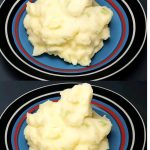Macaroni and Cheese: The Ultimate Comfort Food
There are few dishes more comforting than a big bowl of homemade macaroni and cheese. It’s rich, creamy, cheesy, and deeply satisfying, making it the perfect dish for cozy nights, family dinners, or whenever you’re craving something indulgent. Whether you’re a fan of extra cheesy, ultra-creamy mac and cheese or you prefer a crunchy, golden topping, this classic recipe can be customized to suit your tastes. Ready in just 30 minutes, it’s the ultimate go-to comfort food that will please both kids and adults alike.
Ingredients:
For the pasta:
-
8 oz elbow macaroni (or any pasta shape you prefer)
-
Salt (for boiling water)
For the cheese sauce:
-
4 tablespoons unsalted butter
-
2 tablespoons all-purpose flour
-
2 cups whole milk (or half-and-half for extra creaminess)
-
1 ½ cups sharp cheddar cheese, shredded (or a mix of cheddar and mozzarella)
-
½ cup grated Parmesan cheese (optional for extra flavor)
-
½ teaspoon garlic powder
-
½ teaspoon onion powder
-
Salt and black pepper to taste
-
¼ teaspoon mustard powder (optional, adds depth of flavor)
-
½ teaspoon paprika (optional, for a touch of smokiness)
For the topping (optional but delicious):
-
1 tablespoon butter, melted
-
½ cup panko breadcrumbs or regular breadcrumbs
-
¼ cup shredded cheddar cheese (for topping)
Instructions:
Step 1: Cook the Pasta
Start by bringing a large pot of salted water to a boil. Add the elbow macaroni (or your choice of pasta) and cook it according to the package instructions, usually about 7-8 minutes, until the pasta is al dente (tender but firm). Drain the pasta and set it aside.
Step 2: Make the Cheese Sauce
In a large saucepan, melt the butter over medium heat. Once the butter is melted, whisk in the flour to form a roux (a thickening mixture of fat and flour). Continue whisking for about 1-2 minutes until the mixture turns golden and smells slightly nutty (this step helps remove the raw flour taste).
Gradually add the milk to the roux, whisking constantly to avoid lumps. Bring the mixture to a simmer and let it cook for about 3-5 minutes, stirring frequently until the sauce begins to thicken.
Step 3: Add the Cheese
Once the sauce has thickened, reduce the heat to low. Begin adding the shredded cheddar cheese, a handful at a time, stirring until it’s completely melted and smooth before adding more. Stir in the Parmesan cheese (if using) and season with garlic powder, onion powder, mustard powder, paprika, salt, and black pepper. Taste the sauce and adjust the seasonings to your preference.
Step 4: Combine Pasta and Cheese Sauce
Add the drained pasta into the cheese sauce and stir gently to coat each piece of macaroni in the creamy sauce. If the sauce seems too thick, you can add a splash of milk to reach your desired consistency.
Step 5: Optional: Bake for a Crispy Topping
If you prefer a crispy, golden topping, transfer the macaroni and cheese to a greased baking dish. In a small bowl, mix the melted butter with the breadcrumbs and sprinkle this mixture evenly over the mac and cheese. For an extra cheesy topping, sprinkle a little more shredded cheddar on top.
Bake in a preheated oven at 350°F (175°C) for 20-25 minutes, or until the top is golden and bubbly. This step is optional, but it gives the mac and cheese a delicious crunchy texture that adds another layer of flavor.
Step 6: Serve
Once baked, remove the mac and cheese from the oven and let it cool for a few minutes. Serve hot, garnished with a sprinkle of parsley or extra paprika for added flavor and color. Enjoy!
Tips and Variations:
-
Add-ins for Extra Flavor: You can customize your mac and cheese by adding ingredients like crispy bacon, sautéed onions, or roasted vegetables such as broccoli, cauliflower, or even tomatoes. They’ll add flavor, texture, and extra nutrition.
-
Make It Spicy: If you like a little heat, try adding diced jalapeños, a pinch of chili powder, or a few dashes of hot sauce to the cheese sauce.
-
Try Different Cheeses: For a unique twist, experiment with different cheeses. Gruyère, fontina, mozzarella, or Monterey Jack will all add depth and complexity to the flavor profile.
-
Vegan Mac and Cheese: To make this dish dairy-free, simply substitute dairy-free butter, milk, and cheese alternatives. Nutritional yeast can also be added to create that signature cheesy flavor.
-
For Extra Creaminess: Swap out some of the milk for half-and-half or heavy cream for a richer, creamier texture.
-
Gluten-Free Version: Use gluten-free pasta and a gluten-free flour blend to make the dish gluten-free.
Why This Recipe Works:
-
Quick and Easy: Mac and cheese doesn’t have to be complicated. With just a few simple ingredients and under 30 minutes, you can enjoy a creamy, cheesy bowl of comfort food.
-
Customizable: This recipe is versatile and can be easily adapted to suit your preferences. Add more cheese, spice it up, or include your favorite mix-ins.
-
Classic Comfort: There’s something deeply satisfying about the combination of pasta and cheese. The creaminess of the sauce combined with the richness of cheddar makes this dish irresistibly comforting.
Nutritional Benefits:
While mac and cheese is traditionally a rich, indulgent dish, it can offer some nutritional value when made from scratch. The pasta provides carbohydrates for energy, while cheese adds protein and calcium. The addition of milk or cream enhances the creamy texture while providing some vitamins. You can also boost the nutritional profile by adding vegetables like broccoli, spinach, or cauliflower for extra vitamins, fiber, and antioxidants.
Conclusion:
Macaroni and cheese is a beloved comfort food that’s easy to make and always hits the spot. Whether you like it creamy, cheesy, or with a crispy topping, this recipe gives you the foundation for the ultimate mac and cheese experience. It’s quick, versatile, and sure to be a hit at any table. Whip up a batch for dinner tonight — everyone will be asking for seconds!
Frequently Asked Questions (FAQ)
1. Can I use other types of cheese for this recipe?
Absolutely! While sharp cheddar is the most traditional cheese used in mac and cheese, you can mix and match different cheeses to create unique flavors. Try using mozzarella for a creamier texture, Gruyère for a nutty flavor, or Monterey Jack for a milder taste. A combination of cheeses often results in a richer flavor profile!
2. Can I make mac and cheese ahead of time?
Yes, you can make mac and cheese in advance! Simply follow the recipe until Step 4, then let the dish cool before storing it in an airtight container in the refrigerator. When you’re ready to serve, you can reheat it on the stovetop or in the oven. If you’re reheating in the oven, cover it with foil and bake at 350°F (175°C) for about 20 minutes until warmed through.
3. Can I freeze mac and cheese?
Yes! Mac and cheese freezes well, though the texture of the cheese sauce may change slightly after thawing. To freeze, prepare the mac and cheese as directed, but skip the breadcrumb topping if you’re planning to freeze it. Let it cool completely, then transfer to an airtight container or freezer-safe bag. When ready to eat, thaw overnight in the fridge and reheat in the oven at 350°F (175°C) until hot.
4. How do I make mac and cheese spicier?
If you enjoy a little heat, there are several ways to spice up your mac and cheese! Add finely chopped jalapeños or other fresh chilies to the sauce. You can also stir in chili powder, cayenne pepper, hot sauce, or a sprinkle of red pepper flakes. For a smoky twist, try adding smoked paprika.
5. Can I make mac and cheese without flour (gluten-free)?
Yes! To make a gluten-free version, substitute the all-purpose flour with a gluten-free flour blend or cornstarch. Both can help thicken the sauce without compromising on flavor or texture. Be sure to use gluten-free pasta as well.
Nutrition Facts (per serving, without breadcrumb topping):
-
Calories: 380
-
Protein: 17g
-
Fat: 21g
-
Carbohydrates: 31g
-
Fiber: 1g
-
Sugar: 6g
-
Sodium: 520mg
-
Cholesterol: 50mg
-
Calcium: 30% of Daily Value (DV)
-
Iron: 6% of DV
Note: Nutrition values are based on a typical serving of mac and cheese made with whole milk and regular cheddar cheese. Nutritional information will vary depending on specific ingredients, additions (like bacon or vegetables), and serving sizes.
Cooking Tips:
-
Don’t Overcook the Pasta: Be sure to cook your pasta al dente (firm to the bite). It will continue to cook a bit once mixed with the cheese sauce, so overcooking the pasta can lead to mushy mac and cheese.
-
Gradually Add the Cheese: Adding the cheese in small batches ensures that it melts smoothly into the sauce. Stir constantly to prevent clumps and create a smooth, creamy texture.
-
Season as You Go: Taste the sauce as you go! Cheese can be salty, so you may need less added salt than you think. Adjust the garlic powder, onion powder, and other seasonings to your taste.
-
For a Creamier Sauce: For extra creaminess, substitute half-and-half or heavy cream for the milk. This will result in a thicker, richer sauce, especially if you like your mac and cheese super indulgent.
-
Use Room Temperature Cheese: If you have time, let your cheese come to room temperature before adding it to the sauce. This helps it melt more evenly and prevents clumping.
-
Breadcrumb Topping Variations: For a more flavorful breadcrumb topping, try adding a teaspoon of garlic powder, dried herbs (like thyme or basil), or even grated Parmesan to the breadcrumbs before sprinkling them over the mac and cheese.
-
Add Vegetables: Sneak in some extra nutrition by adding vegetables to your mac and cheese. Broccoli, spinach, or cauliflower work particularly well. Just sauté or steam them beforehand and mix them in with the pasta before adding the cheese sauce.
-
Rest Before Serving: After baking or mixing, let your mac and cheese sit for a few minutes before serving. This allows the sauce to set and prevents it from being too runny.
-
Use an Immersion Blender for a Smooth Sauce: If you prefer an ultra-smooth cheese sauce, blend the sauce with an immersion blender before adding the pasta. This creates a silky texture, perfect for those who dislike chunks
Conclusion:
Macaroni and cheese is a classic that never goes out of style. It’s a dish that can be made in so many different ways, but the foundation remains the same: tender pasta smothered in a rich, creamy cheese sauce. Whether you prefer your mac and cheese with a crispy, golden topping or straight from the pot, this simple yet satisfying recipe is guaranteed to warm you up from the inside out.
So gather your ingredients, get ready to indulge, and enjoy one of the best comfort foods out there. With a little creativity and a few twists, mac and cheese can be personalized to suit any taste!



